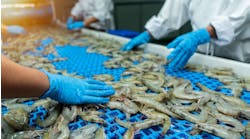“We sought to increase safety, reliability and productivity of field operations through people by improving monitoring and control of the process.” Braskem’s Marco Santos discussed the use of wearable technologies at the company’s integrated polyethylene plant in Nanchital, Mexico.
“People as an asset are very important in industry,” said Marco Santos, production engineer, Braskem Idesa. “Braskem Increases reliability and productivity by investing in improving their skills.”
Santos described his plant’s experience with wearable mobile technology at Honeywell Users Group Americas 2019, this week in Dallas.
Braskem is first in production of thermoplastic resins in America and in use of 100% renewable raw materials, producing 16 million tons per year of chemical and petrochemical products in 36 facilities, $23 billion in sales and $2.4 billion in earnings before interest, tax, depreciation and amortization (EBITDA).
Santos has been with the Braskem Idesa integrated polyethylene plant in Nanchital, Mexico, since its startup in 2016. The plant produces more than a million tons per year from ethane, a process that involves “pressures to 3,000 bar (43,500 psi)—a very risky plant,” he said. “We’re investing to mitigate the risk.”
Digital transformation is the company’s “most important way to reach our excellence imperative,” Santos said, with initiatives around the world in many departments. The Nanchital plant’s digitalization focus includes operations, with machine learning (predictive and prescriptive maintenance), and using Honeywell-powered mobile headsets for two-way video and sound communications in an initiative called Cyclops.
“Our Cyclops project began after I talked with Honeywell about scenarios as I worked with the plant on startup in 2016,” Santos said. “My concerns were focused on the operators. We had cell phones, laptops and the DCS, but, in the field, no tools for operators, just pencil and paper to take data.”
The paper-based system made it difficult to see what direction the process was going or to detect deviations. “We also wanted a better way to transfer knowledge to new operators,” Santos said. “We sought to increase safety, reliability and productivity of field operations through people by improving monitoring and control of the process.”
Intelligent wearables program
The Nanchital plant signed on with Honeywell for a three-year subscription to software, apps and service for Connected Plant wearables. The augmented-reality headsets provide task automation, where workers receive guidance and can visualize system information and documents to perform their tasks correctly. Workers can also get expert assistance—the experts can access the worker’s head-mounted display camera and use video chat to offer advice.
“With Cyclops, we’re increasing reliability, productivity and operational skills, and monitoring startup and shutdown activities,” Santos said. “When the devices are used, we can communicate and coach the operators in real time. When we inspect raw materials, we can consult the specifications. For safety, the operators can take video evidence of unsafe acts and conditions and report them in real time to other operators and supervisors.”
Technicians have access to lock out and tag out equipment and deliver it for maintenance, and communication between control room and field operators improves overall effectiveness. Videos of field operations can be used as tutorials to teach new operators unfamiliar procedures.
Santos gave a live demonstration of connectivity among the conference room in Dallas, the plant in Mexico and Braskem US headquarters in Philadelphia. He showed attendees how he could smoothly guide the operator with text and graphics, turn a headlamp on and off, designate features to draw attention, take and annotate still images, make text notes and join with remote experts.
Santos said the plant’s next steps include implementing Movilizer, a handheld system that guides and records operator and maintenance rounds, and intelligent vests for real-time monitoring of worker vital signs and environmental conditions. He said, “This is just one step on our journey to Industry 4.0, to increase reliability and productivity by investing in people.”





